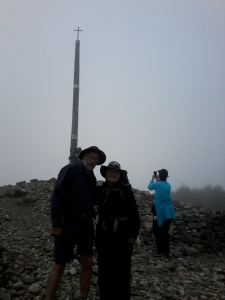Our camino has ended, and here we are outside the cathedral in Santiago. But one of the philosophies about the camino is that once the walking bit is over, the true camino starts. We both need to reflect on just what that means for us both, but one of the key thingsis that this experience is changing for all of us.
We have spent the last three days just blobbing out, being tourists for a while and catching up with friends as we see them here in the city. We have been to Finisterre, which is a sort of ritual most pilgrims undertake. The custom used to be tat you burnt your clothing out there, at what was at one stage thought to be the end of the world. These days that practice is discouraged, though there is plenty of evidence to say it still happens. These Kiwi pilgrims contented themselves with each throwing into the sea a piece of greenstone that had travelled from home and had been with us throughout the walk.
It is with mixed feelings that we sit here in this lovely city. The daily routine of the pilgrim is slowly leaving us,though with others around us still imbued with getting up early, it is difficult to have a sleep in! But it is a great pleasure for us to meet with many of our new friends as they finish and as they leave this city to head home or to new adventures.
To Amigo Alan -thanks for your reply. We will go back to the Post Office on Friday before we leave and see if they can find anything.
We will be going to Pontevedra on Friday to meet with Anna. Our plan is then to be back in Bilbao by Tuesday evening and then on to Barcelona and then home.
Alan,
Santiago, Spain.






